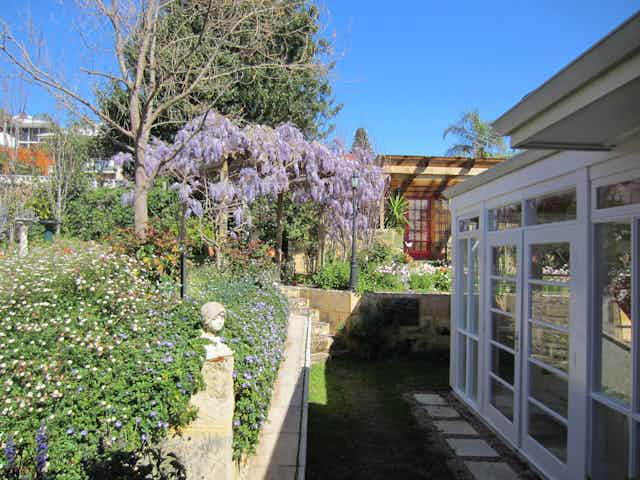The traditional Australian suburban backyard is being lost to higher-density housing and massive project homes on small lots.
City planning is focused on making cities more compact, which in some ways is desirable, and the large backyard is seen as unsustainable and undesirable because of the space it consumes. But its loss could well be increasing the risks of physical and mental health problems among city residents.
Further reading: Planners know too little about the ‘depressogenic’ city
Private and secure backyards are places where people can retreat from the relentless pressures and intensity of city life. This sort of open space may provide the essential nurturing environment city dwellers need to cope mentally and physically with the stresses of their lives.
And cities are stressful places in which to live and have always been so. In the second century AD, Roman poet Juvenal wrote that the noise and lack of sleep in Rome was a major problem. Only wealthy Roman citizens could deal with the stress by building homes surrounded by peaceful gardens outside the city centre.
How is our health affected?
Today, evidence shows us that city dwellers, while benefiting from the advantages of city living, also suffer.
For instance, they are more likely to experience anxiety and depression, and their risk of psychosis increases dramatically. City dwellers have been shown to have a 39% greater risk of mood disorders and a 21% added risk of anxiety disorders compared to rural dwellers.
Life stresses clearly play a major role in causing poor mental health among city dwellers, but the impact of the environment cannot be ignored. A recent review of 50 studies shows that an environment devoid of nature may have undesirable impacts on health or quality of life. Part of the problem lies in the visual absence of plants and landscape.
Further reading: Hug a tree … it really will make you feel better
Research also finds that play-oriented green spaces benefit children’s mental development.
It’s reasonable, then, to suggest that a lack of landscaped settings, such as backyards, could reduce emotional wellbeing, particularly among people less able to cope with mental stresses.
A place of vanishing backyards
Perth, where project homes bigger than 300 square metres are common, provides an interesting case study.
When devising Perth planning policies in the 1950s, Gordon Stephenson argued that the large backyards associated with Australian homes reduced the need for large public recreation areas. The backyard was seen as necessary for healthy city living.
By the 1970s, land subdivisions in Perth usually produced a residential lot around 600m2 with a frontage of 20 metres. Because project homes were so much smaller then, with a minimum 6m rear setback, a Perth family usually had a backyard of 120m2 at the very least. These areas provided space for large trees, cubby houses, climbing frames, swings, gardens and area to throw a ball.
Today, Perth planning regulations require private open space smaller than a double garage per family household. Houses like those of Alkimos and Ellenbrook, on Perth’s fringes, spread almost from boundary to boundary.
The houses comply with Perth planning requirements that allow areas under eaves, patios, verandahs and paved parking areas to be included in open space calculations.


Starved of space, and hotter
The result is little useful recreational outdoor space. Far from being child-friendly, these family homes without backyards are restricting our children from enjoying a normal active life in the safety of their homes.
Children have to use indoor spaces for recreation. This usually take the form of sedentary entertainment sources such as television and electronic games, adding to a great public health problem confronting our children. Obesity is associated with a lack of exercise as well as eating fast food.
Reducing open green space is also increasing urban temperatures, with major physical health consequences. All Australian capitals will increase significantly in average temperature by 2050. Perth will become Australia’s hottest capital with estimated heat-related deaths increasing from 294 a year to 1,419, many more than the city’s annual road toll.
It has been known for many years that the best way to combat urban heat is by providing well-landscaped open spaces with large trees. This is the very type of space that many large backyards provided.
We can confirm this cooling effect using thermal imaging. This thermal image of suburban Perth, taken on a 38-degree day, shows that landscaped backyards in older suburbs (blue) are far cooler than more intense housing developments with little private open space (orange to red).

Further reading: Why poorer suburbs are more at risk in warming cities
Leadership is needed
What can and should be done?
The principle is simple: in the suburbs we need to build smaller two-storey project homes with large backyards open to the sky, just as they have learnt to do in the suburbs of European cities. The role of these backyards can change as family lifecycle needs change.
Achieving this, however, will be difficult. Australians show little self-control of their consumption even when warned of the consequences.
A change is needed, driven by courageous, sensible and forward-thinking politicians who can see beyond the compact city pushed by planning bureaucrats.

